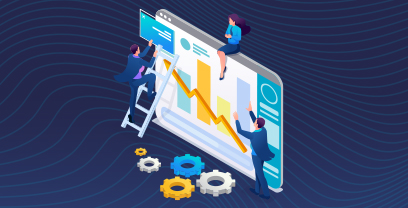Choosing the right Source-to-Pay (S2P) tools can be overwhelming. It requires you to juggle multiple priorities: unifying systems, improving visibility, reducing risk, and proving ROI across every stage of the procurement process.
So where should you start, and what capabilities truly matter in a modern S2P platform?
In this blog, we walk through the most important tools for supporting each stage of the S2P lifecycle and what to look for in an enterprise-ready solution.
Key Takeaways
- Source-to-Pay platforms provide end-to-end visibility and control, helping organizations streamline procurement, reduce risk, and drive strategic value across the procurement lifecycle.
- The right S2P tools are highly configurable and scalable, supporting integration with ERP, AP, and other systems while adapting to your unique processes and maturity level.
- Success depends on choosing a platform that unifies data, simplifies user experience, and supports cross-functional collaboration.
| Learn how Ivalua’s Source-to-Pay solution can streamline procurement and deliver enterprise-wide impact. Find Out More |
Source-to-Pay Tools: The Problems an Integrated Procurement Process Solves
Disconnected systems, manual workarounds, and limited visibility create friction at every stage of the procurement process. But a unified Source-to-Pay platform is built to eliminate these inefficiencies and help your team move faster, work smarter, and make better decisions.
Here’s a quick look at seven common procurement challenges and the capabilities that address them. We’ll break each one down in more detail in the sections that follow.
| Procurement Challenge | What an Integrated S2P Platform Solves |
| Siloed supplier data | Centralized supplier management and risk visibility |
| Slow or inconsistent sourcing processes | Streamlined, standardized sourcing with guided workflows |
| Limited contract visibility | Digitized contract lifecycle management with real-time access, alerts, and reporting |
| Off-contract or maverick spend | Stronger compliance through contracts, catalogs, and policy controls |
| Manual invoice handling and late payments | Automated invoicing with 3-way match and early payment options |
| Poor budget alignment and forecasting | Real-time spend tracking and planning tools |
| Low adoption across teams and business units | Intuitive UI, role-based access, and built-in collaboration |
Benefits of Using Source-to-Pay Tools
An integrated S2P platform brings measurable benefits across every stage of the procurement lifecycle, including:
- Efficiency gains: Automated workflows, centralized data, and seamless handoffs between sourcing, contracting, purchasing, and payment eliminate manual effort and reduce cycle times.
- Cost savings and reduced maverick spend: By improving visibility and control, S2P tools help enforce purchasing policies and drive contract compliance. They can also help to surface opportunities for savings.
- Risk mitigation and compliance enforcement: Built-in risk indicators, audit trails, and policy controls ensure procurement stays aligned with internal standards and external regulations.
- Improved supplier relationships and collaboration: With a shared platform for onboarding, performance tracking, and communication, suppliers are more engaged and aligned, leading to better service and stronger supplier partnerships.
- Better, data-driven decision-making: End-to-end visibility into supplier performance, spend trends and risk exposure helps you make data-informed decisions and reduce risk exposure.
Together these benefits make a strong case for Source-to-Pay software. The table offers a more detailed look at how S2P tools can solve for some of the most complex procurement pain points and risks.
| Pain point | Procurement risk | S2P Benefits |
| Disconnected supplier data and no risk visibility | Hidden exposure to non-compliance and delivery issues | Unified supplier profiles and real-time risk insights |
| Manual sourcing and RFX processes | Slows time-to-contract | Automated sourcing events with audit-ready records |
| Contract fragmentation and version control issues | Missed obligations and inconsistent enforcement | Centralized contract repository with version control and alerts |
| Off-contract spend and low spend policy adherence | Lost savings and compliance risks | Guided buying and catalog management with built-in controls |
| Slow, error-prone invoice processing | Late payments and strained supplier relationships | Validated e-invoicing with exception handling |
| Payment delays and poor cash visibility | Missed discounts and planning challenges | Integrated payables and real-time cash flow tracking |
| No holistic view of supplier performance | Missed improvement opportunities and unmanaged risk | Central dashboards and lifecycle-wide spend analytics |
Now that we’ve talked about the benefits of an S2P platform, let’s dive into the tools and features that are most impactful for streamlining and improving procurement from source to pay.
Key Source-to-Pay Tools Across the Full Procurement Lifecycle
Source-to-Pay isn’t a single workflow but rather a connected lifecycle that spans everything from supplier onboarding to final payment. To be effective at the enterprise level, your platform needs to support every stage with tools that work together seamlessly.
The features below map to each phase of the Source-to-Pay process, helping teams streamline operations, reduce risk, and drive measurable value across the business.
Supplier Management
An effective Source-to-Pay process begins and ends with suppliers. That’s why managing supplier data, risk, and performance in one unified platform is essential.
Even a single underperforming or non-compliant supplier can cause serious problems, and when information is spread across spreadsheets, emails, and siloed systems, it’s nearly impossible to respond quickly or evaluate suppliers consistently.
With a strong Supplier management software, procurement teams gain a complete picture of supplier health and can act faster when issues arise.
Key capabilities
- Supplier onboarding: Digitize and streamline onboarding workflows, ensuring suppliers meet requirements from day one.
- Supplier risk management: Monitor financial, operational, and compliance risk in real time, with automated alerts for high-risk signals.
- Supplier performance management: Track KPIs and feedback across business units to ensure consistent, accurate evaluations over time.
Why it’s crucial
- Disruption from underperforming or high-risk suppliers is costly.
- Manual tracking across systems reduces oversight and slows decisions.
- Fragmented views lead to inconsistent evaluation.
What to prioritize
- Real-time risk signals to flag issues early
- Consistent evaluation criteria across categories and regions
- Seamless onboarding that connects to sourcing, contract, and compliance workflows
Real-world example
Procurement teams who use Ivalua benefit from centralized scorecards and onboarding documentation to create a single source of truth for each supplier. Alerts automatically trigger when key certifications expire or when performance metrics fall below target, prompting scheduled reviews and proactive risk mitigation.
Strategic Sourcing
From RFX creation to bid evaluation and award, Strategic sourcing software helps to ensure every sourcing event is executed efficiently and transparently.
Why does it matter? Because inconsistent sourcing processes can lead to biased decisions, missed savings, and supplier selection that doesn’t align with risk or compliance requirements. Without a clear audit trail or standardized scoring model, it’s difficult to scale best practices across the enterprise.
Key Capabilities
- RFX automation: Standardize and automate RFI, RFP, and RFQ processes with built-in templates and guided steps.
- Supplier scoring and bid evaluation: Use weighted criteria to compare bids objectively and align with cost, quality, or sustainability goals.
- Collaboration across departments: Enable sourcing, legal, finance, and other stakeholders to review and weigh in on decisions in real time.
Why It’s Crucial
- Ensures transparency and fairness in supplier selection
- Streamlines sourcing across business units and regions
- Reduces cycle time and helps eliminate evaluation bias
What to Prioritize
- Configurable templates that speed up event creation
- Weighted scoring models for objective, criteria-based decisions
- Integration with supplier and contract data to inform awards with full context
Real-World Example
Procurement teams automate bid scoring using predefined criteria such as cost, ESG performance, and production capacity so that every award decision is data-driven and aligned with organizational priorities.
Contract Management
Contract lifecycle management software helps maintain consistency with how supplier contracts are stored, tracked, and followed, and they bring structure and visibility to every stage of the process. They help prevent outdated terms or missed renewals, reducing compliance risk and off-contract spend.
With a centralized approach, legal and procurement teams can collaborate efficiently to track redlines, manage approvals, and store final contracts alongside sourcing and supplier data. Integration with sourcing and procurement ensures that negotiated terms carry through to execution.
Key Capabilities
- Contract authoring: Create contracts using clause libraries, pre-approved templates, and guided workflows to ensure consistency and reduce legal risk.
- Contract approval workflows: Automate and track multi-level approvals with built-in routing, notifications, and audit trails.
- Central contract repository: Store all contracts in a single, searchable location with version control and metadata tagging for easy access and reporting.
Why It’s Crucial
- Reduces legal and compliance risk
- Speeds negotiation and renewal cycles
- Avoids off-contract commitments and missed savings
What to Prioritize
- Version control to manage edits and redlines across teams
- Searchable repository to find contracts and clauses instantly
- Cross-functional review workflows to streamline approvals and ensure alignment
Real-World Example
Legal and procurement teams collaborate in-platform, redlining contracts, managing version history, and completing approvals without ever leaving the system. This keeps processes transparent, speeds up negotiations, and ensures all terms are enforceable and accessible.
e-Procurement
e-Procurement software brings control and simplicity to the purchasing process, making it easier for employees to follow policies and still be productive. They guide users through compliant purchasing paths and automate approvals, ensuring every request aligns with the budget and the organization’s business goals.
By contrast, when proper controls are missing, organizations can experience maverick spend, delayed approvals, and a lack of visibility into what’s being purchased and why. eProcurement solves this by embedding controls into the buying experience itself.
Key Capabilities
- Catalogs: Offer guided buying through approved vendor catalogs, with contract pricing and policy-aligned options.
- Purchase requisitions: Enable users to request both catalog and non-catalog items, with automated budget and compliance checks.
- Approvals: Route requisitions through configurable, role-based workflows with real-time status tracking and notifications.
Why It’s Crucial
- Improves policy adherence by embedding controls into the request process
- Reduces maverick spend by guiding users to approved options
- Enables budget control at the point of request, not after the fact
What to Prioritize
- Real-time budget visibility to prevent overspending
- Role-based approval logic to route requests efficiently and accurately
- Intuitive UI for buyers to increase adoption and reduce support burden
Real-World Example
End-users browse guided catalogs to create purchase requests, while the system automatically checks against budgets and routes for approval, ensuring compliance without manual oversight.
Invoicing
E-invoicing software ensures that what gets ordered, received, and billed all aligns, without bogging teams down with manual reviews. It provides invoice automation from intake to validation and approvals, as well, so you can process payments faster while reducing errors and risk.
With automated routing in place, invoices that are missing purchase orders or contain mismatches are flagged, annotated, and sent to the right approver, keeping the process moving without compromising control.
Key Capabilities
- 3-way matching: Automatically match invoices with POs and receipts to ensure accuracy before payment.
- Exception handling: Identify mismatches or missing data and route to the appropriate stakeholder with contextual notes.
- ERP integration: Sync invoices across systems in real time to maintain a single source of truth for finance and procurement.
Why It’s Crucial
- Cuts manual processing time and reduces human error
- Flags discrepancies before payment is issued
- Supports compliance and simplifies audits with full traceability
What to Prioritize
- Tolerance rules to determine which discrepancies need review
- Configurable workflows to route exceptions efficiently
- Multi-ERP sync to centralize visibility and control across business units
Real-World Example
When an invoice arrives without a PO, the system automatically flags it, adds an exception note, and routes it to the correct approver, ensuring quick resolution without breaking the payment workflow.
Payments
Payments may be the final step in the Source-to-Pay process, but it’s where real value can be realized – or lost.
Strategic payment tools help you move beyond simply issuing checks to actively managing cash flow, capturing discounts, and strengthening your supplier relationships.
Key Capabilities
- Dynamic discounting: Enable early payment offers based on supplier terms, improving margins while supporting supplier cash flow.
- Payment scheduling: Manage payment timing across suppliers, geographies, and currencies to optimize liquidity.
- Treasury integration: Ensure real-time coordination with treasury and AP systems for accurate planning and execution.
Why It’s Crucial
- Reduces payment friction and manual effort
- Captures early payment discounts to drive savings
- Supports liquidity planning and working capital optimization
What to Prioritize
- Real-time status tracking for payment visibility across systems
- Integration with AP systems to streamline processing and ensure accuracy
- Flexible remittance options to support supplier preferences and global requirements
Real-World Example
Buyers use automated payment tools to trigger early payment offers based on negotiated terms and available budget. As a result, payments become more of a strategic lever for savings and creating goodwill with your best suppliers.
Spend analysis
Spend analysis gives procurement teams the insights they need to drive smarter decisions across sourcing and supplier negotiations, to budgeting and compliance. It helps to transform raw transaction data into actionable intelligence by surfacing trends and identifying risks.
Strong spend management solutions should include real-time dashboards, automated classification, and tight integration with procurement and finance systems. These capabilities ensure that teams can act quickly on insights that are data-driven and accurate.
Key Capabilities
- Analytics and Reporting: Track KPIs, trends, and cost-saving opportunities with dynamic visual dashboards.
- Spend visibility and classification: Classify and aggregate data across categories, suppliers, and business units for a unified view of total spend.
- Compliance tracking: Identify off-contract spend and measure adherence to policies and contracts.
Why It’s Crucial
- Enables smarter sourcing, forecasting, and budgeting decisions
- Identifies off-contract and non-compliant spend early
- Provides trusted data to support supplier negotiations and risk planning
What to Prioritize
- Real-time dashboard access for proactive monitoring and reporting
- Automated classification logic to streamline analysis and maintain accuracy
- Integration with procurement and finance for a complete, trusted data set
Real-World Example
Procurement teams use Ivalua’s all-in-one spend analysis dashboard to track tail spend, flag low-compliance categories, and uncover new opportunities to reduce costs and consolidate suppliers.
| Download the Source-to-Pay Buyer’s Guide for expert insights, key evaluation criteria, and a clear roadmap to make an informed decision. |
How to Choose the Right S2P Tool for Your Business
So, how do you find the right platform to support your organization’s goals, scale with your needs, and empower your teams? Below are five key criteria to consider as you evaluate solutions.
Integration Capabilities (ERP, AP, CRM)
A Source-to-Pay platform is only as strong as its ability to connect with the rest of your ecosystem. Look for tools that integrate seamlessly with your ERP, accounts payable systems, and CRM platforms.
Real-time data synchronization across these systems ensures procurement stays aligned with finance while reducing manual rework and enabling accurate reporting. APIs, native connectors, and pre-built integrations are all indicators of strong interoperability.
Scalability for Enterprise Needs
As your procurement function evolves, your S2P platform must evolve with it. Your platform should support multi-entity structures, growing data volumes, and increasing user counts.
Consider solutions with proven enterprise implementations, flexible configurations, and global support capabilities.
Compliance and Audit Features
Regulatory pressure and internal risk policies demand robust compliance controls. The right S2P solution should offer full audit trails, permission-based access, and automated policy enforcement across sourcing, contracts, payments, and supplier management.
These capabilities help your organization’s procurement activities remain transparent and standards-compliant.
User Experience and Training/Adoption
A powerful platform only delivers value if teams actually use it. Prioritize solutions with a modern, intuitive user interface, customizable dashboards, and guided workflows that simplify complex tasks.
Additionally, built-in training tools and contextual help, as well as role-based access, simplify the process of onboarding new users and help to drive increased adoption.
Procurement Maturity and Roadmap Alignment
Your organization’s procurement strategy should guide your S2P technology choice. Consider where you are today – with manual processes, limited visibility, or siloed systems – and where you want your organization to be. Look for platforms that can support your roadmap with modular capabilities, AI-driven insights, and innovation that matches your pace of transformation.
| Planning your S2P rollout? Download our Source-to-Pay Implementation Guide for best practices, key milestones, and expert tips to ensure a successful deployment. |
Maximize Strategic Value with a Unified, Scalable S2P Platform
Driving strategic value across the entire source-to-pay cycle requires more than a collection of tools. It demands a unified, configurable platform that offers end-to-end visibility and control. By integrating seamlessly with ERP, AP, and other enterprise systems, modern S2P solutions streamline procurement processes, reduce risk, and adapt to your organization’s unique workflows and maturity level.
In fact, according to Forrester’s Total Economic Impact Report, organizations using Ivalua have achieved a 393% Return on Investment (ROI), thanks to these benefits. With a simplified user experience, centralized data, and built-in support for cross-functional collaboration, Ivalua empowers teams to make faster, smarter decisions at every stage of the procurement lifecycle.
Download the TEI study for free.
Explore how our Source-to-Pay software can help you transform fragmented data into a strategic asset with real-time analytics, automated classification, and full contract lifecycle management and visibility.
| See how Ivalua’s S2P platform can transform your procurement process. Watch Demo | Find Out More |
FAQs about Source-to-Pay Tools
How do Source-to-Pay tools integrate with existing ERP systems?
Modern Source-to-Pay tools integrate with ERP systems through APIs, connectors, or middleware, allowing real-time data exchange. Procurement, finance, and supplier information can be easily accessed and securely shared, without disrupting existing workflows.
What level of configurability should I expect from a Source-to-Pay platform?
A strong S2P platform should offer no-code configuration for workflows, forms, approval rules, and user roles, so you can adapt the solution to your business needs without having to rely heavily on IT.
Can one platform really manage the entire procurement lifecycle?
Yes. An end-to-end S2P platform is designed to handle everything from sourcing and contracting to invoicing and payments, with integrated analytics and supplier management to ensure full visibility and control.
What is the difference between S2P and P2P?
Source-to-Pay (S2P) covers the entire procurement lifecycle, including sourcing, contracting, and supplier management, while procure-to-pay (P2P) focuses on purchasing, invoicing, and payments.
How long does implementation typically take?
Implementation timelines vary based on scope and complexity, but enterprise-grade S2P platforms typically take between three and nine months, with modular rollouts allowing for a phased adoption.
Further Reading
Blogs:
Source-to-Pay vs. Procure to Pay
The Comprehensive Guide to the Source-to-Pay Process
What is Source-to-Pay (S2P)? Process, Definition and Examples
Spend Analysis: Maximize Cost Savings in Procurement
Reports:




